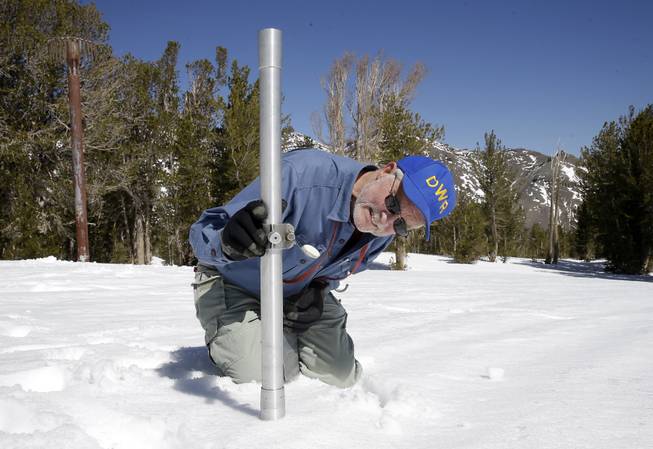
Rich Pedroncelli / AP
In this April 28, 2015, file photo, Frank Gehrke, chief of the California Cooperative Snow Surveys Program for the Department of Water Resources, checks the depth of the snow pack as he does a snow survey at Leavitt Lake near Bridgeport, Calif.
Monday, Oct. 31, 2016 | 1:52 p.m.
SPOKANE, Wash. — The western United States set records for low winter snowpack levels in 2015, and a new report blames high temperatures rather than low precipitation levels, according to a new study.
Greenhouse gases appear to be a major contributor to the high temperatures, according to the study published Monday in the journal Geophysical Research Letters.
Scientists looked at snow-measurement sites in California, Oregon, Washington, western Nevada and western Idaho. They found that in 2015, more than 80 percent of those sites experienced record low snowpack levels as a result of much warmer-than-average temperatures.
Most of the previous records were set in 1977, a drought year, said Philip Mote, lead author of the study and director of the Oregon Climate Change Research Institute at Oregon State University.
"The 2015 snowpack season was an extreme year," Mote said. "But because of the increasing influence of greenhouse gases, years like this may become commonplace over the next few decades."
Winter snowpack in the mountains is important in the arid West because the melting snow provides precious water in dry months. The snow drought last winter led the governors of California, Oregon and Washington to order reductions in water use.
California has been in a drought since 2011. Oregon and Washington experienced much higher-than-average temperatures during the 2014-15 winter, but they were not as dry overall as California, the report said.
"The story of 2015 was really the exceptional warmth," said Dennis Lettenmaier of the University of California at Los Angeles, co-author of the study.
"Historically, droughts in the West have mostly been associated with dry winters, and only secondarily with warmth," Lettenmaier said. But in 2015, "the primary driver of the record low snow packs was the warm winter."
For 111 of the snow-measurement stations in the region, the April 1 reading was zero for the first time ever, essentially indicating that there was no snow left, the study found. The overall snowpack level on April 1 in California and Oregon was 90 percent below average, the report found.

Join the Discussion:
Check this out for a full explanation of our conversion to the LiveFyre commenting system and instructions on how to sign up for an account.
Full comments policy